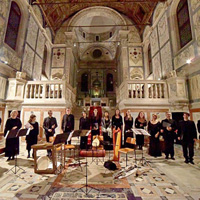
Se la face ay pale
new production of the missa by Guillaume Du Fay
Fondazione Benetton Studi Ricerche and almamusica433 present, within the project Musica antica in casa Cozzi (Early music at Casa Cozzi), a new production of the missa Se la face ay pale by Guillaume Du Fay (1397-1474).
The production is the outcome of a Medieval Song and Music workshop conducted by Claudia Caffagni, professor at the Civic Music School “C. Abbado” of Milan. The workshop began in January 2016, and has been attended by young musicians from Italy as well as from the rest of Europe, United States, Brazil and Korea, all having well-regarded concert experience. Starting from the direct analysis and study of the chosen source, Trent Codice 88 (the oldest among the complete available sources that have preserved the missa), the research has dealt with and probed all the issues put forth by this type of approach, with a view to a historically informed performance, also thanks to the scientific cooperation of Fondazione Ugo e Olga Levi.
Se la face ay pale, which has been defined by the English musicologist David Fallows as «the most joyful and the most elegant Dufay’s Mass», was composed by Guillaume Du Fay in the 1451-1452 period, during his time at the court of Louis, Duke of Savoy as choirmaster and court counsellor. According to a recent assumption (Anne Walters Robertson, The man with the pale face, the shroud, and Du Fay’s Missa Se la face ay pale, «Journal of Musicology», October 2010), stemming from a Christological interpretation of the text of the ballade of the same name (Se la face ay pale, la cause est amer) written by Du Fay at the Savoy court in the thirties, the occasion for composing the missa was the transferral of the Holy Shroud of Christ, by Marguerite de Charny to Louis, Duke of Savoy. The paleness, the “face pale” of the loved one is assumed to be a clear reference to Christ’s pale and sorrowful face.
The teaching residency projects is housed by casa Luisa e Gaetano Cozzi in Zero Branco, Treviso. The farmhouse, immersed in a rural settings, is a place that naturally befits artistic production thanks to the ability to effortlessly draw its guests into an “otherworldly” environment, enveloped in the deep silence that is ideal for musical creation.
The students who took part in the workshop have worked in Austria as well, in the small town of Maria Saal, where is Tonhof – literally translated, “the courtyard of sound”. This house has an equally strong calling for music – formerly the summer residence of the Austrian writer Thomas Bernhard, it is nowadays the headquarters of the Trigonale Festival.
The production will be recorded and debuted in both countries where the workshop took place:
Saturday 8 October 2016, Church of Santa Caterina, Treviso, Italy
Sunday 9 October, Church of Santa Maria dei Miracoli, Venice, Italy
Saturday 15 October 2016, Seminarkirche, Tanzenberg (St. Veit an der Glan), Austria
